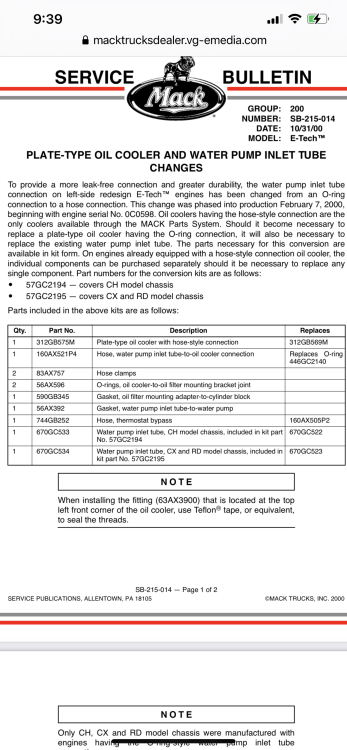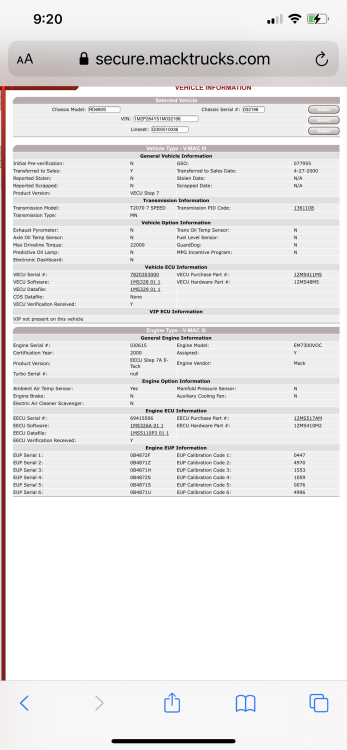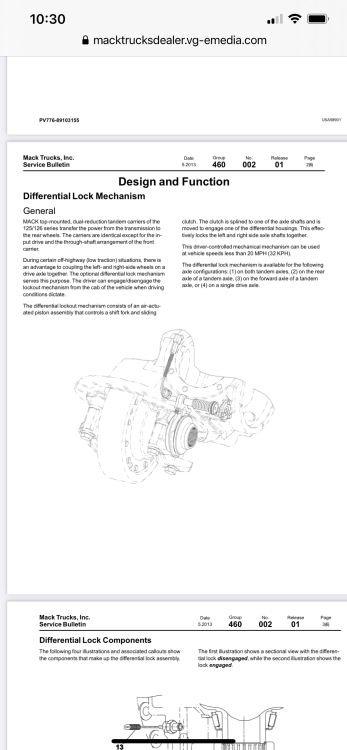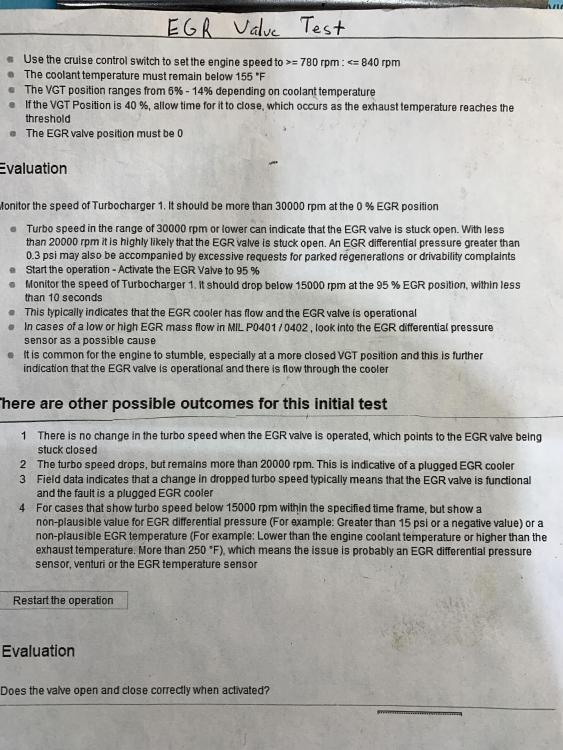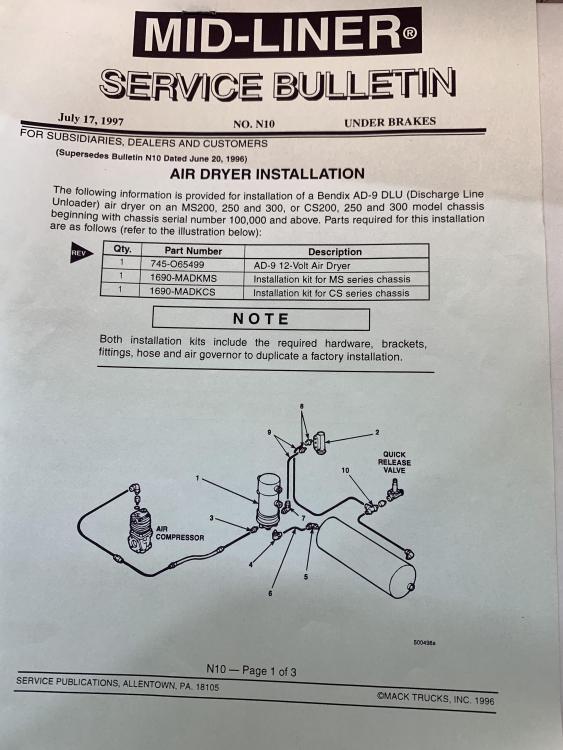
Mackpro
BMT VIP-
Posts
3,012 -
Joined
-
Last visited
-
Days Won
10
Content Type
Profiles
Forums
Gallery
Events
Blogs
BMT Wiki
Collections
Store
Everything posted by Mackpro
-
Leaking internal trans cooler on a 04 cx613 eaton 10
Mackpro replied to Larry H's question in Mack Truck Q & A
I wish other manufacturers would follow Eaton Fuller and have free access to all their manuals and bulletins. Sheppard steering gear is another good company with free manuals and a good technical hot line. TRW steering gear company also had manuals online however its been many years since I’ve checked to see if it’s still free. Bendix has a good website and Meritor/WABCO air drier did too last time I checked. . -
The wire usually falls back behind the batteries and is forgotten. Used to see this a lot at the dealership when batteries were replaced or tested
-
The power wire to the ACM was left off the batteries . This powers the ACM , def pump and level sensor . It’s a smaller wire with a in line fuse
-
Email sent . The fuel dye test is always the best option.
-
On the common rail engines there is lots of planes under the have cover to leak . If no one has been into the injectors then probably not the injector lines . There is a service bulletin on this issue and have seen this first hand . It was only on the Common rail MP7’s. The is a plug left loose in the back of the head behind the cam gear. Message me your email and I can send you the bulletin
-
If the red and yellow light both are on it’s usually low coolant issue. This can cause the engine to shutdown if set in the parameters. If it’s only the red shutdown light on then it’s low oil pressure or high coolant temp which can shut the engine down as well. The Etech RD series of trucks use a mixture of electronic and manual gauges. The oil pressure gauge is mechanical but has a sensor on the filter stand that feeds info to the engine ecm . So your gauge could read correctly but the engine ecm is only seeing what the sensor is telling it which could be 0 psi causing the engine to shutdown. Coolant temperature is the same way . The coolant temp sensor that sticks out the side of the water manifold is for the gauge only. The one that sticks out the back towards the firewall is for the engine ecm only. And just like the oil pressure, what your gauges tell you your ecm might be seeing something different.
-
First problem was when activated the dash would beep once to let you know it engaged. The light showing it was engaged was on the switch. Drivers forget they engaged it and take off down the road and Kaboom. The software update made the buzzer stay on while it was engaged this help the problem. The second problem was getting it to disengage. I believe once the air was let off the spring pushed the plunger to unlock it . The spring is not that strong.
-
I forgot to add . The Diff lock switch is electric and sends voltage to the solenoid pack back on the frame rail . This sends air to the diff lock actuators on the carriers
-
Mack re-introduced the inter-wheel diff lock a few years back probably because they were loosing sales to Meritor. They lock in abs function great . It’s the unlocking is the issue. We have them on some of our CXU’s . Sometimes you have to drive in a figure 8 on a gravel parking lot to get them to unlock .
-
It’s the newer Mack carriers.
-
I’ve been hearing lots of complaints of the inter-wheel lock not unlocking after you hit the switch to unlock them . And of course the carrier explodes. All my dump truck buddies took the air lines off the carriers for the inter wheel locks. Mack has a recall/campaign for software update on the dash cluster to keep the alarm going when it’s locked in . The recall was for GU and GRs . PI0889 is the recall number. My old dealership had 7 at one time with exploded carriers. The actual actuator is air powered . There is a sending unit that screws into the housing that tells if it’s engaged. This is not to be confused with the regular power divider.
-
Being a 93 I assume it’s a VMAC 1 electronic engine However in a rare chance It could be a mechanic fuel pump engine. On all VMAC 1,2 and 3 CH/CX the speedometers are all set the same on the dip switches on the back of the speedo head. The tire size, gear ratio, trans tone wheel teeth ( usually 16) and trans top gear ratio are all changeable using the appropriate Mack software or Tech Tool. That’s how you calibrate the speedo. The new replacement speedo heads are different on the dip switches. Have you replaced the speedo head lately?
-
2010 Mack Vision automatic issues
Mackpro replied to Shortcut's topic in Electrical, Electronics and Lighting
https://www.globaltransmissionsupply.com/eaton-fuller-transmission-fault-codes this works on the original Ultrashifts but not sure on the Ultrashift Plus . Most problems we saw were wiring harness/power supply , the XY shifter on top of the trans and clutch issues. -
If it starts but you have to crank on it 8-10 seconds every time then it could be either of the timing sensors. When one goes bad it runs off the the other one but it’s hard to start like it’s a fuel issue. Or someone adjusted the valves wrong. As in when the flywheel pointer was on 1/6 they adjusted cylinder 1 instead of cylinder 6. Seen that happen several times.
-
2010 Mack Vision automatic issues
Mackpro replied to Shortcut's topic in Electrical, Electronics and Lighting
Mdrive or Eaton Ultra shift plus? -
-
Won’t start working till 150 degree coolant temp. Then it’s only by request by engine ECM
-
Is it saying that it will derate to 5mph in a certain amount of minutes?
-
-
I saw lots of delete related fan clutch issues and hear of even more today from friends at dealerships. The huge Borg Warner Cool Logic fan clutch was a disaster and Mack kept using it till 2013-14 . Then the smaller Behr fan came out in a kit with fan blade and all needed parts included. Bad news is to make it work correctly the engine ECM needed to be reprogrammed from the dealership. The dealership contacts Mack and they make the change in the programing for that specific truck and the dealership programs the ECM with the complete program. Sadly you can’t pick and choose what you want going back in to the ECM. It’s all or nothing. Same goes for changing to a air fan clutch. Now I’m hearing that several guys who already changed to the new fan clutchs and got the correct program installed by the dealership then later got theirs deleted and now the fan clutch won’t engage because the file the delete guy put in has the old Borg Warner fan clutch programing mixed in with it. It was quite a mess for a lot of guys. Most all of these delete guys know nothing of the actual files going into the trucks . They go buy a bootleg version of Tech Tool and have some out of country 3rd party people remote in using Team Viewer and shoot the software into the truck . I have not seen it affect trucks that already had air fan clutches on them though. However never really saw very many Mack Mp truck with air fans. Mostly Fleet trucks like UPS and Kenan seemed to always use Horton air fans. Air fan on Volvos are super common.
-
MP8 oil cooler
Mackpro replied to Walkyrie_Engineering's topic in Modern Mack Truck General Discussion
On your oil filter stand there are 2 different oil control solenoids that control oil to the piston cooling nozzles and the oil temperature. The engine ECM controls these solinoids. No exact data on actual temps they are trying to achieve though. But 250 degrees in the summer is common. You always want your oil temp at least over 212 to boil off water /condensation.
BigMackTrucks.com
BigMackTrucks.com is a support forum for antique, classic and modern Mack Trucks! The forum is owned and maintained by Watt's Truck Center, Inc. an independent, full service Mack dealer. The forums are not affiliated with Mack Trucks, Inc.
Our Vendors and Advertisers
Thank you for your support!





